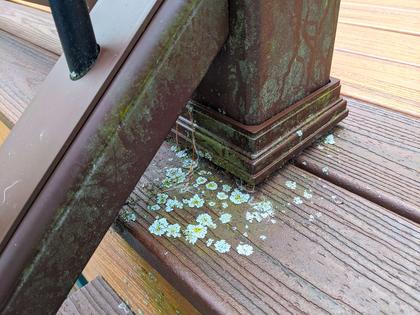Ask the Builder: Deck sealer dilemma
You might be one of the countless homeowners frustrated with the annual or biannual task of cleaning and sealing your wood deck. I’m right there with you, as I have to deal with my wood dock and the stairs leading to it. It’s a wretched job that can span days. It’s no wonder you might be drawn to the composite decking displays at local home and garden shows.
Over the past three decades, I’ve been lucky enough to obtain inside information about exterior wood sealers. Add to this the knowledge I discovered while researching my "Roofing Ripoff" book exposing the shingle industry. You probably know that the sun’s ultraviolet (UV) rays are harmful, but you might not know the actual mechanism. Once you do, you grasp why deck sealers are doomed from the get go.
The UV rays can contain active photons. Think of these tiny things as miniature cruise missiles. When the photon crashes into your outdoor flag, wood deck, house paint, metal roof or flashings, it splits molecules apart and rips atoms off objects. These photons have so much energy they can blast atoms of copper or zinc from your roof. It’s child’s play for them to destroy thin deck sealer films that sit up on top of the wood.
To make matters worse, your deck is horizontal and gets a point-blank blast from the UV rays in the middle of the day. The rays have to pass through the least amount of protective atmosphere at midday. Have you ever wondered why your deck railing balusters don’t look so bad? They receive a harmless glancing blow from the UV rays at noon. In the morning they receive a direct hit from the UV rays, but the photons have to pass through so much atmosphere their energy is dissipated. This is why you struggle to get sunburned at sunrise and sunset.
As if this weren't enough torment, the wood you’re using outdoors is hygroscopic. This means it expands and contracts in response to moisture content. Sealers prevent this movement because they don’t allow water to enter the wood. If you stop sealing wood, within a few years it looks like a neglected fishing pier with cracks large enough to swallow a handful of BBs.
These cracks start off small. They’re very tiny checking cracks. The cracks allow water to penetrate deeper into the wood. As the cracks get wider and deeper, the swelling and shrinking forces become stronger. This is why it’s imperative you keep outdoor wood sealed so water doesn’t rip your lumber apart.
I think you can see why four decades ago a new industry was born. That’s when the first composite deck products hit the market. As time marched on, improvements were made and more exterior products were made from plastics so you wouldn’t have the constant job of painting or sealing them.
I have 1,700 square feet of composite decking here at my own home. I didn’t build the house I live in now. The homeowner had the original Trex decking installed. I remember when it was introduced to the marketplace. It had an antiseptic appearance and only resembled wood by its shape. Seven years ago, I ripped it all up and installed Trex Transcend for the decking and ralling system.
My wife, who dislikes all wood-imitation products, was amazed at how realistic the product looks. I’ve never cleaned the decking, and yet it looks as good as the day I installed it. Algae, pollen and lichens do accumulate in shady areas. The good news is all of these things are easily washed off using a soft brush that you might use to clean your RV.
If you decide to free yourself from the chore of cleaning and sealing your wood deck, be aware that composite decking requires great attention to detail when installing it. Add to this the price. The top-line composite deck products are expensive.
Composite decking products, while not hygroscopic, expand and contract. The movement can be substantial. You must take this into consideration when installing the decking or you’ll have a huge mess on your hands. Read the installation instructions and follow them to the letter.
If you decide to install composite decking on a treated lumber undercarriage, read the installation instructions. The composite decking products can sag if you space the floor joists too far apart. By default this happens if you decide to install the decking at a diagonal on your deck.
You’ll also want to protect your investment by using the newer joist tape products. This tape is applied to the top of the joists before the decking is installed. It prevents water from entering the wood. Without this protection, water can enter tiny cracks created by the decking fasteners. As you already know, these cracks can get bigger over time. When this happens, the fasteners holding down your expensive composite decking loose their gripping power.
========
Subscribe to Tim’s FREE newsletter at AsktheBuilder.com. Tim offers phone coaching calls if you get stuck during a DIY job. Go here: go.askthebuilder.com/coaching
©2024 Tim Carter. Distributed by Tribune Content Agency, LLC.







